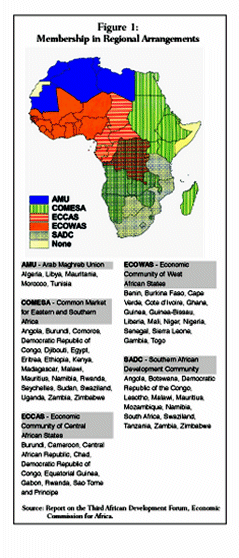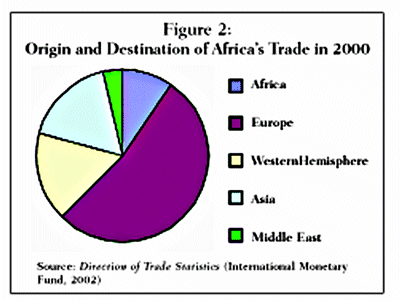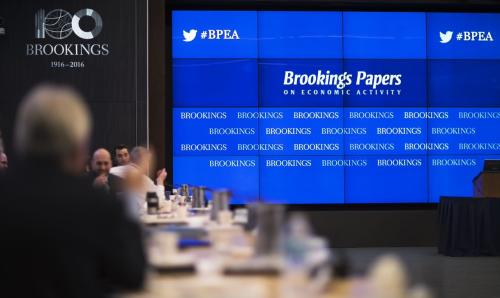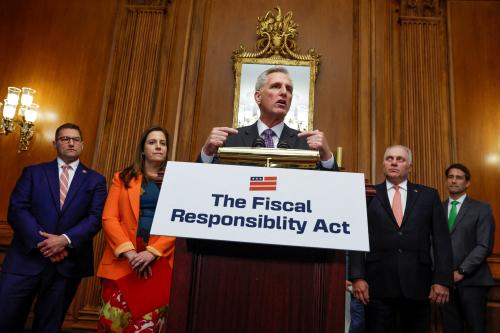Africa, like other regions of the world, is fixing its sights on creating a common currency. Already, there are projects for regional monetary unions, and the bidding process for an eventual African central bank is about to begin. Is it worth the effort, and will it provide an important solution to Africa’s problems? Most observers judge that those problems are linked to civil conflicts, corruption, absence of rule of law, undisciplined fiscal policies, poor infrastructure, and low investment—the last of which is due in part to foreign investors’ mistrust of African governments.
Monetary union can in fact address very few of Africa’s fundamental ills. At best, it can produce low inflation, but it cannot guarantee growth, and at worst, it can distract attention from essential issues. A more promising initiative is the New Partnership for African Development (NEPAD), through which African countries hope to exert peer pressure to correct governance failures and thus make progress in correcting Africa’s problems. It is too early to see how effective that process will be, but if it succeeds, monetary union can crown that achievement. If not, monetary union will almost certainly fail, and highlight Africa’s more fundamental policy failures.
POLICY BRIEF #121
Africa has suffered from decades of decline and marginalization, as the early hopes of rapid development and enlightened government after independence were dashed by poor economic policies, civil wars, and kleptocratic rulers. This tragedy has led, first, to a reexamination of the effectiveness of aid by the major donor countries, and second, a recognition by Africans that they need to take charge of their own destiny. Two years ago NEPAD was launched as a vehicle for improving economic and political governance by Africans, and thus of assuring donors (and private investors) that resource flows to Africa would not be wasted. Its importance for continuing aid flows from the rich countries was reiterated at the June 2003 summit of the G-8 countries in Evian, France. However, if African countries do not get their macroeconomic policies right, they will not benefit from better economic and political governance and the associated capital inflows. Instead, they will continue to stagnate, and rich countries will draw lessons from past aid ineffectiveness and increasingly shun the continent.
One important aspect of macroeconomic policies is the choice of the exchange rate regime and the associated monetary policy. In this context, a policy proposal currently receiving much attention addresses the creation of a common African currency. The project, though not explicitly linked to NEPAD, is intimately associated with the newly-formed African Union (AU), which is the larger institutional framework within which NEPAD operates. A common currency was also an objective of the Organization for African Unity and the African Economic Community, the predecessors of the AU.
The 1991 Abuja Treaty establishing the African Economic Community outlines six stages for achieving a single monetary zone for Africa that were set to be completed by approximately 2028. In the early stages, regional cooperation and integration within Africa would be strengthened, and this could involve regional monetary unions. The final stage involves the establishment of the African Central Bank (ACB) and creation of a single African currency and an African Economic and Monetary Union.
In addition to establishing the African Union, the 1999 Sirte Declaration calls for shortening implementation periods in order to speed up the process for creating institutions such as the African Central Bank. Though the bank would not be created until around 2020, the bidding process for its location is likely to begin soon, and Ghana and Botswana are among those that would like to host it. In the meantime, there are plans for creating various regional monetary unions, which would presumably form building blocks for the single African central bank and currency. However, the various subregional groupings currently in place (and which do not necessarily correspond to those that would ultimately form the single African currency) have very different starting points with respect to macroeconomic stability, and there is even more diversity within the regions. This calls into question whether a common currency is possible, even over the fairly long horizon embodied in the AU Treaty.
Why Monetary Union?
There are two principal reasons for the enthusiasm for monetary union in Africa. First, it is clear that the successful launch of the euro has stimulated interest in other regions. From Latin America to the Middle East and East Asia, monetary union is seen as a way of reinforcing regional cohesion and demonstrating a commitment to regional solidarity. However, it is sometimes forgotten just how long the road to monetary union in Europe actually was. The transition was fraught with obstacles and missteps, and even in official circles there were doubts until the ultimate day of the changeover whether the replacement of national currencies by euro notes and coins in January 2002 would go smoothly. Designing new institutions that were able to deliver stability-oriented monetary policy—particularly the European System of Central Banks—was complicated, as was creating the Solidarity and Growth Pact, which provides for regional coordination of fiscal policies. Despite the intense planning process, the institutions are still the object of considerable controversy and contention. If the process was so difficult for a set of rich countries with highly competent bureaucracies which have cooperated closely for more than fifty years, then realistically, the challenge for African countries must be considered enormous.
The second important motivation in Africa has been the desire to counteract perceived economic and political weakness by putting in place regional institutions, of which a common currency and monetary union would be potent symbols. What is less well understood is that a common currency may be the symbol of weakness, not strength—as was the case for the ruble in the dying days of the Soviet Union and at the time of the creation of the Commonwealth of Independent States. A currency that is ill-managed and subject to continual depreciation is not likely to stimulate pride in the region or give the member countries any clout on the world stage. Moreover, as Robert Mundell, the 1999 Nobel Prize winner in economics, emphasizes, it is great countries (or regions) that make great currencies. While the countries in the euro zone are important enough economically for the euro eventually to rival the dollar, that is not likely to be the case for an African currency even in the best circumstances. Africa’s Gross Domestic Product (GDP) is, and is likely to remain, only a small fraction of that of Europe or the United States—in fact, at present it is roughly equal to Belgium’s.
The State of African Currencies
Africa already has two functioning monetary unions: the CFA franc zone (composed mainly of former French colonies, with the currency linked to the euro) and the Common Monetary Area, (CMA, centered on South Africa’s rand). Both are longstanding and have been generally successful in providing low inflation. However, both have also suffered from periods of instability. In 1994, the CFA franc was devalued by 50 percent, while the rand has experienced a marked depreciation against major currencies since 1990, and a recent period (1998-2002) of especially high volatility. Moreover, trade remains low in the CFA zone—intra-CFA trade is only 7 percent of total trade—and the zone has not grown noticeably faster than neighboring countries. In southern Africa, the smaller CMA members have tended to converge toward South Africa’s higher per capita income, but the same is even more true for Botswana, which left the monetary union in 1976.
Prospects for Regional Monetary Unions
As mentioned above, there are already several projects for new regional monetary unions in Africa.
The West African Monetary Zone is to be created in July 2005 and is to lead in 2006 to a merger with the West African part of the CFA franc zone to produce a single currency for the Economic Community of West African States (ECOWAS), which counts fifteen countries among its members, including the eight members of the CFA franc zone plus Cape Verde, the Gambia, Ghana, Guinea, Liberia, Nigeria, and Sierra Leone. However, Nigeria will make a difficult partner for the rest of West Africa. Given Nigeria’s much larger size, large budget deficit, generally undisciplined fiscal policies, and an export structure that differs greatly from its neighbors (which export other primary commodities while Nigeria exports oil), Nigeria has the potential to influence monetary policies in ways that potential partners in a monetary union would find undesirable. Without an effective way of disciplining countries’ fiscal policies and in the absence of similar shocks to the prices of countries’ exports and imports (or “terms of trade”), a single currency for ECOWAS would not seem advisable.
In Southern Africa, countries that comprise the Southern African Development Community (SADC) intend to form a monetary union, though this is a much vaguer and more distant project. Many SADC members are in any case very far from macroeconomic stability. The southernmost countries, South Africa and other members of the Southern Africa Customs Union, are reasonably advanced and stable. However, their neighbors to the north include countries with recent or continuing problems of civil unrest (Angola, Democratic Republic of the Congo, and Zimbabwe) as well as some facing severe drought and poverty (Malawi and Zambia, for instance). Their financial systems are generally much less developed than those of the southernmost countries and the shares of manufactures in production and exports are low.
The Commonwealth of Eastern and Southern Africa (COMESA), a group of countries that cuts across two geographical regions, also is developing a monetary union project, and three of its members—Kenya, Tanzania, and Uganda—plan to revive the East African Community that dissolved in the decade following independence. Indeed, these different projects illustrate a pervasive problem in Africa—overlapping commitments that are not necessarily consistent. Within the five main regional groupings associated with the AU (the three mentioned above along with the Arab Maghreb Union and the Economic Community of Central African States), ten countries belong to more than one regional grouping, with the Democratic Republic of the Congo holding three memberships (see figure 1).

Attempts to advance on too many fronts often result in inaction. Disparities among COMESA countries are about as important as those affecting SADC; but COMESA’s drawback is that South Africa—the greatest pole of monetary stability in the region—is not one of its members. Various officials have suggested merging or closing down some regional groupings, or having each country choose a single arrangement to which it would belong. It will be important to rationalize regional commitments to maximize their effectiveness.
Rather than aiming for new, ambitious monetary unions, a more promising strategy would be to build on the credibility of existing monetary unions (the CFA franc zone and the CMA) by adding to them countries that have demonstrated their commitment and ability to deliver sound economic policies by satisfying convergence criteria for a significant length of time. Unfortunately, the western African CFA franc zone has been hurt by unrest in Cote d’Ivoire and its central African counterpart is composed mainly of oil-producing countries with pronounced terms of trade swings. Extending the CMA, where South Africa is a fairly stable, developed pole, may be a more attractive possibility in the short run. However, its SADC neighbors are, with a few exceptions, too far from the macroeconomic stability necessary to converge with South Africa and share the same currency, so many will not be candidates to join for decades. Moreover, the strategy of making good policies a precondition for entrance into a monetary union is fully consistent with the principles of NEPAD, namely peer review by African countries. This approach, if properly applied, can be expected to be much more effective than external pressures exerted by donors or by international financial institutions. But it is unlikely to favor the quick enlargement or de novo creation of monetary unions.
Is a Common African Currency a Good Thing?
An important motivation for monetary union in Europe was to reduce the costs of changing money associated with trade and tourism. However, intra-African trade is modest, so gains for a monetary union deriving from lower transactions costs would necessarily be much smaller than in Europe. Consistent with the gravity model, which posits that a country will trade more with countries that have higher per capita incomes, most African trade is conducted with the richer countries of Europe, North America, and Asia (see figure 2), and will remain so.
 A second important reason to create a monetary union may be to improve on the monetary policies provided by national central banks, which have typically fallen prey to pressures to finance government deficits and hence have produced high inflation and depreciating currencies. There may be some advantage to delegating monetary policy to insulate it from pressures to finance governments. However, unless this occurs in the context of a large, stable anchor country (e.g., South Africa) or existing multilateral institutions with a track record of independence and sound policies (e.g., the West African CFA franc zone’s central bank), new institutions are unlikely to provide a durable “agency of restraint.” Instead, large countries (whose governments exert an important influence over monetary policy actions) will continue to use the central bank as a printing press, directly or indirectly financing their spending. This was the experience before the 1994 devaluation of the CFA franc in both western and central CFA franc zones. Hopefully, reinforced fiscal surveillance and the recent agreement to eliminate completely central bank advances to governments have solved the problem in the CFA franc zone. However, the mere creation of a regional central bank will not ensure its independence from fiscal policy.
A second important reason to create a monetary union may be to improve on the monetary policies provided by national central banks, which have typically fallen prey to pressures to finance government deficits and hence have produced high inflation and depreciating currencies. There may be some advantage to delegating monetary policy to insulate it from pressures to finance governments. However, unless this occurs in the context of a large, stable anchor country (e.g., South Africa) or existing multilateral institutions with a track record of independence and sound policies (e.g., the West African CFA franc zone’s central bank), new institutions are unlikely to provide a durable “agency of restraint.” Instead, large countries (whose governments exert an important influence over monetary policy actions) will continue to use the central bank as a printing press, directly or indirectly financing their spending. This was the experience before the 1994 devaluation of the CFA franc in both western and central CFA franc zones. Hopefully, reinforced fiscal surveillance and the recent agreement to eliminate completely central bank advances to governments have solved the problem in the CFA franc zone. However, the mere creation of a regional central bank will not ensure its independence from fiscal policy.
Monetary arrangements cannot provide solutions to the profound development problems facing many African countries. At best, a monetary regime supported by fiscal discipline and good structural policies can provide a framework for low inflation. It cannot guarantee high growth. Thus, monetary union should not be seen as a panacea or be driven by a grandiose political vision that hopes to find a symbol of unity and stability when the reality is quite different.
The Way Forward
The solution to African economic problems does not lie with political gestures and grand schemes. Appropriately, the creation of NEPAD is a recognition that governance problems are key, and that it is the responsibility of African governments to put their own houses in order—but also that peer pressure within Africa can help in that process. There are four priority areas where actions by African countries are most essential:
- Stop regional conflicts through regional peacekeeping forces and by making concerted regional efforts to prevent armed involvement and material support of rebels by neighboring countries
- Increase transportation and communication links to stimulate trade and competition and to exploit economies of scale
- Adopt sustainable macroeconomic policies by making currencies convertible and monetary policies consistent with low inflation, reducing budget deficits, and eliminating central bank financing of government spending
- Promote and attract investment in infrastructure, health, and education by convincing donors and private investors of African countries’ ability to provide a stable, non-corrupt environment based on the rule of law.
NEPAD must prove itself in the above four areas, and deliver on its peer review mechanism. If it does, and a genuine domestic consensus in favor of sound policies emerges in African countries, Africa can benefit from more generous aid flows from donors, as was recently reaffirmed by the G-8 countries at their Evian summit. Moreover, monetary union should then be easy to achieve, to “crown” the reality, not just the promise, of African unity. However, if NEPAD and African governments fail, they risk getting lower aid flows than in the past, as donors, noting a history of aid ineffectiveness, pull back further. Attempts to forge a grand monetary union would likely produce yet another failure that harms, rather than helps, regional solidarity and integration.
The NEPAD process has just begun. As of May 31, 2003, fifteen African countries have agreed to submit themselves to the African Peer Review Mechanism (APRM), a self-monitoring organization comprised of African Union member states. The purpose of the peer review panel, which will have between five and seven members, is to promote the implementation of policies and standards that will lead to political stability, economic growth, development, and integration on a regional and continent-wide level. The recently selected panel consists of six well- respected Africans from various disciplines and includes Graça Machel, humanitarian, former first lady of Mozambique, and wife of former South African President Nelson Mandela.
How the APRM will be applied, however, has yet to be seen. Signals from heads of state are thus far not promising. If Thabo Mbeki cannot bring himself to condemn Zimbabwe’s excesses in both the political and the economic realm, what hope is there for frank discussion and finger- pointing at lesser sins, like budget deficits over 5 percent of GDP or excessive foreign borrowing?
African leaders must recognize and assume responsibility for their current financial problems in order to pave the way toward regional economic integration. On the contrary, if nations throughout Africa continue to be beset by civil wars, poor infrastructure, unsustainable fiscal policies, and low investment linked to corruption and the absence of rule of law, a monetary union will only accentuate the failure of Africans to tackle these more fundamental problems.


